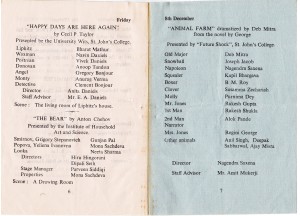Civil servant, travel writer and poet Sandeep Silas strings a garland of peace
The Hindu covered the Launch ceremony of “Garland Of Peace” idea and initiative on October 21, 2009

Link:
http://www.thehindu.com/features/friday-review/art/peace-strings/article36681.ece
http://www.thehindu.com/multimedia/dynamic/00008/22dmc_sandeep02_jpg_J_8895g.jpg
The recently concluded photo exhibition by Sandeep Silas at the India Habitat Centre propagates war ravaged sites of the world to be united in a “Garland of Peace.”
Each country of the world has hidden its war wounds for reasons of disgust, shame and hurt national pride.
He feels that so classified war ruins and sites can create a powerful movement for peace amongst all nations.
Images of Hiroshima and Pearl Harbor on the same platform along with sites like Lion Hill, Waterloo, Belgium; Menin Gate in the town of Ypres, Belgium; the Auschwitz concentration camps; Anzac Cove, Turkey; Fort Siloso in Singapore; Bridge on the River Kwai, Thailand; St. Paul’s Church, Ambala, India; the Berlin Wall, Germany, and the Bamiyan Buddhas, Afghanistan, were on display as reminders of past wars. Quotes and thoughts of Gandhi and Nehru on peace and war were thought provoking.
Let there be peace
Silas belongs to the rare group of crusaders whose formidable asset is the cerebral world of ideas. Such is his ability that the ideas grow faster than grass and thought in layers, as enumerated in the Yaksh Prashna put to Yudhishthir in the Mahabharat.
The idea is to declare war-ravaged world sites and buildings as peace heritage sites.
The concept “Garland of Peace” is to string these ruins and sites into a garland of peace building, peace education, peace tourism and peace activism having a lasting influence on present and future generations — the leaders of tomorrow.
To delve further, Silas suggests formation of a peace heritage committee by the United Nations with the objectives of identifying the ruins, preserving them, and putting into place a mechanism to develop these sites as the property of the world community, as the indifference and neglect of the nations gives rise to feelings of revenge and hate towards the aggressor.
The esoteric idea may emerge in a form that seems formidable, but already the impossible has been made possible. The Wailing Wall at Jerusalem is worshiped by the Jews and the Muslims. Similarly in India, Kurukshetra, the battleground of the epic Mahabharata, is a place of pilgrimage to understand the futility of war and learn the essence of the Gita.
Silas, while following the doctrine of the Gita, i.e., do your duty without expecting the reward, has tasted the fruits of his ideas.
As a civil servant, travel writer, poet, he has successfully implemented the concept of a mobile science exhibition on rails in 2003.
“Discover India by Rail” (Sterling publication), “Morrows Face” and “Borrows in the Mist” are significant contributions to the world of poetry. Recently the Sri Lankan government has accepted his suggestion of a Sita-Ram heritage tourism trail in Sri Lanka for the promotion of tourism.
Life is beautiful
Now busy with his novel concept, “Garland of Peace”, he feels that life is beautiful and unique, and let there be no “apocalyptic third war”. Torture, atrocities and humiliation are natural consequences of war, and by wearing the “Garland of Peace” he resolves to prevent war.
With his thought-provoking concept, he has already been well received by stalwarts such as Karan Singh, Kapila Vatsayan, Martand Singh (INTACH) and his alma-mater, the Maxwell School, New York.
Please follow and like us:
 Sandeep Silas speaking at the Commemorative & Currency Coin Release Ceremony!
Sandeep Silas speaking at the Commemorative & Currency Coin Release Ceremony!
 Hon’ble Minister of Railways Shri Nitish Kumar delivering his Address! Proud to have served under you Sir! Truly, you are a visionary, great, fair & impartial administrator with a sound grip on the system! A statesmanlike person who respects his talented officers and works as an exemplary team leader! You taught me many important lessons of life, Sir!
Hon’ble Minister of Railways Shri Nitish Kumar delivering his Address! Proud to have served under you Sir! Truly, you are a visionary, great, fair & impartial administrator with a sound grip on the system! A statesmanlike person who respects his talented officers and works as an exemplary team leader! You taught me many important lessons of life, Sir! Hon’ble Finance Minister of India, Shri Jaswant Singh addressing the audience!
Hon’ble Finance Minister of India, Shri Jaswant Singh addressing the audience! The Release of the Commemorative & Currency Coin!
The Release of the Commemorative & Currency Coin!





![BEAUTIFUL THOUGHTS by [Silas, Sandeep]](https://images-eu.ssl-images-amazon.com/images/I/51T%2BzYeK4uL.jpg)
















